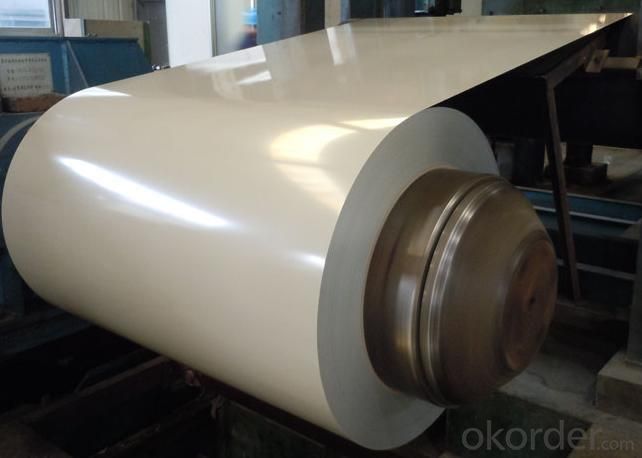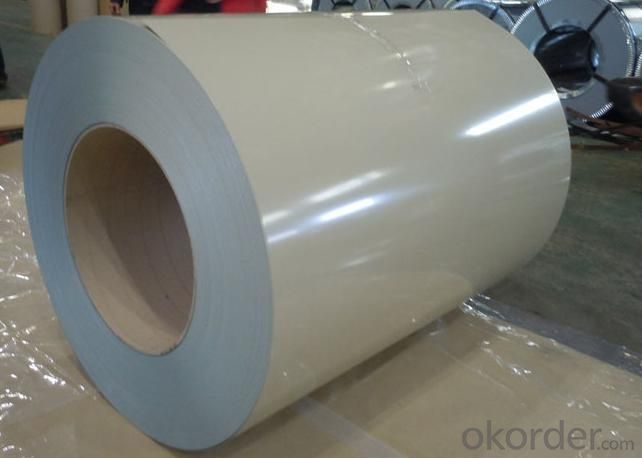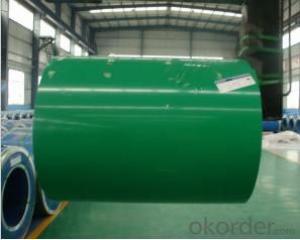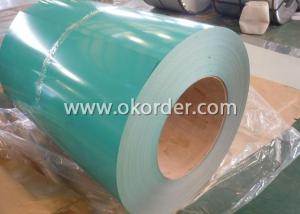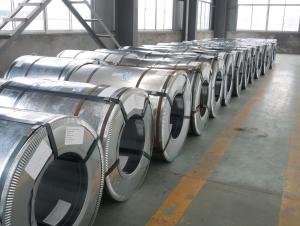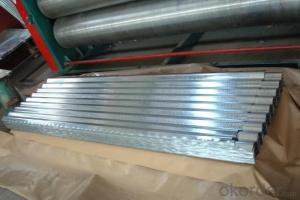Hot Sell Prepainted Aluzinc Steel Coil-RAL9003
- Loading Port:
- China Main Port
- Payment Terms:
- T/T or L/C
- Min Order Qty:
- 50mt m.t.
- Supply Capability:
- 100,000 mt/year m.t./month
OKorder Service Pledge
OKorder Financial Service
You Might Also Like
Hot Sell Prepainted Aluzinc Steel Coil-RAL9003
With GL as base metal, after pretreatment (degrease and chemical treatment) and liquid dope with several layers of color, then after firing and cooling, finally the plate steel is called pre-painted aluzinc steel. Pre-painted Aluzinc steel is good capable of decoration, molding, corrosion resistance. It generally displays superior workability, durability and weather resistance.
General Information Of Hot Sell Prepainted Aluzinc Steel Coil-RAL9003
Thickness | 0.23-1.2mm (BMT) |
Width | 900-1250mm |
Alu-zinc Coating | 50-150g/m2 |
Internal Diameter | 508mm or 610mm |
Color | According to RAL color fan |
Coil Weight | 4-8MT |
Quality | Commercial and structural quality |
Paint | Polyester paint for topside, epoxy for reverse |
Standard | JIS G 3322, ASTM A755M, EN 10169 |
Package | Full wrapped with anti-damped paper inside, iron sheet wrapped outside, and bundled by iron strips |
Base Steel Grade | SGCC, SGCD, DX51D+Z DX52D+Z; S200GD, S220GD, S280GD,S350GD,CS,FS,SS |
Technical Data Of Hot Sell Prepainted Aluzinc Steel Coil-RAL9003
Chemical Composition | C | Si | Mn | P | S |
0.04-0.06% | 0.01-0.03% | 0.18-0.22% | 0.014-0.016% | 0.006%-0.009% |
Technical Data Of Hot Sell Prepainted Aluzinc Steel Coil-RAL9003
Yield Strength | (Mpa) 280-320 |
Tensile Strength | (Mpa) 340-390 |
Elongation | 20%-30% |
Reverse Impact | 9J |
T-bending | ≥2T |
Pencil Hardness | ≥2H |
Duration Of Salt Spray Test | 500 H |
Bending At 180 Degree | No crack, purling and fraction |
Application Of Hot Sell Prepainted Aluzinc Steel Coil-RAL9003
It can be widely used in transportation, light industry, civil usage and farming. It is also the perfect building material in construction for making steel roofing, corrugate sheet, sandwich panel for wall or roofing, facade wall,shutters and home appliance.
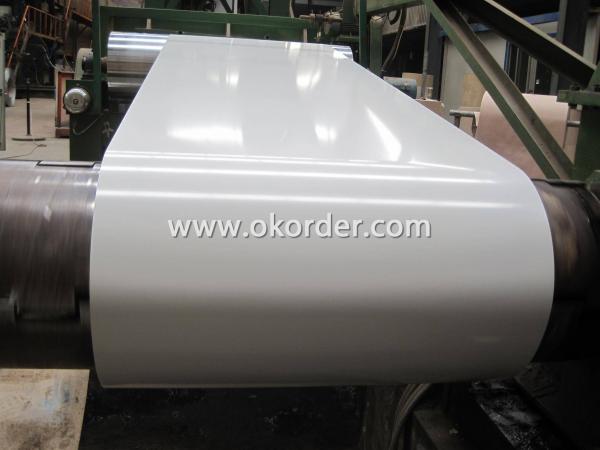
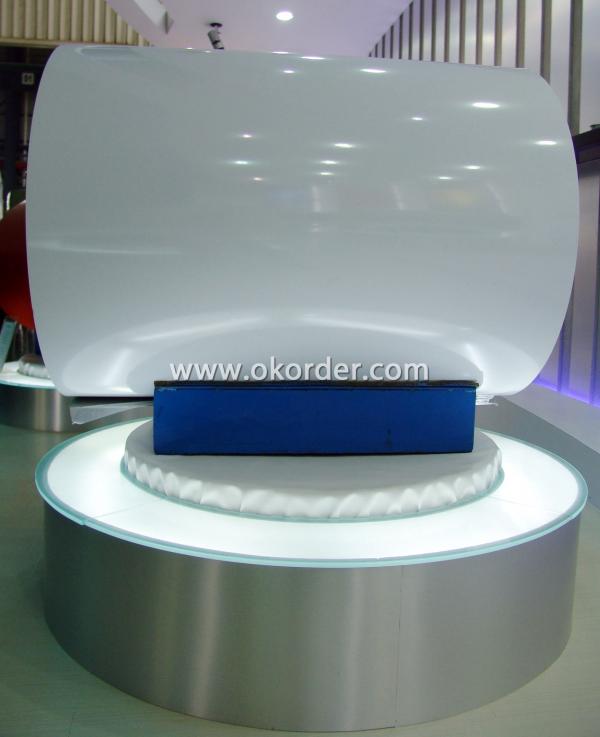
Packaging & Delivery Of Hot Sell Prepainted Aluzinc Steel Coil-RAL9003
The packing of coils consists of anti-damp paper, PVC film, hardboard paper, steel box, strapped with steel strips, fitted with locks and edge protectors and guarantees the optimal condition of the delivered goods. Each coil can be additionally fitted with wooden/steel skids(eye to the side) or wooden pallets(eye to the sky).
Delivery Detail: As customer requested
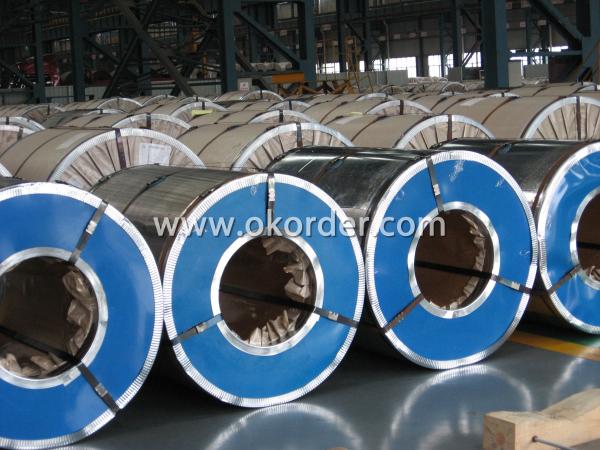
- Q: How are steel coils used in the production of steel nails?
- Steel coils are used in the production of steel nails as they serve as the primary raw material. The coils are unwound and fed into a nail-making machine, where they are cut, shaped, and formed into individual nails. This process allows for efficient and consistent nail production, ensuring high-quality and durable nails for various construction and manufacturing purposes.
- Q: How are steel coils used in the production of electrical motors?
- Steel coils are used in the production of electrical motors as they serve as the core component of the motor's electromagnetic system. These coils are wound around a laminated steel core to create an electromagnet that generates the magnetic field required for the motor's operation. The steel coils, when energized with electric current, produce a magnetic field that interacts with the stator and rotor to facilitate the conversion of electrical energy into mechanical energy.
- Q: Can steel coils be coated with organic materials?
- Yes, steel coils can be coated with organic materials. Organic coatings such as paints or varnishes can be applied to steel coils to provide protection against corrosion, improve aesthetics, or add other desired properties.
- Q: What are the different types of steel coil slitting lines?
- There are several different types of steel coil slitting lines, including rotary shear slitting lines, loop slitting lines, and drag tension slitting lines.
- Q: my sister is making rolls and we have no idea what steel cut oats are. can someone please help with this?
- These are oat grains that are cut with steel sheers intstead of being put the a roller processing system . These are most favored for making true oat porridge . If you really hate preparing breakfast , purchase some of these . Place them in your crockpot over night with milk or water ( your choice ) add what you like raisins cranberries , nut other dried fruits turn on low . Breakfast will be ready and waiting when you get up in the morning just make the coffee or tea . My favorite is to mix in milk , shredded carrot , dried cranberries , b. walnuts and maple syrup . Note : contrary to my predecessor , these have more nutritiional value as they havenot been so heavily processed . Quick and instant oats are just a waste nutritionall speeking . Anything that must be fortified has been over processed .
- Q: I want to save water $$, so I want to use frozen steel to cool my coke. possible or no?
- can't freeze it but ya can make it very cold
- Q: What are the different types of welding methods used for steel coils?
- There are several different types of welding methods used for steel coils, including gas metal arc welding (GMAW), flux-cored arc welding (FCAW), shielded metal arc welding (SMAW), and submerged arc welding (SAW). Each method has its own advantages and is used based on the specific requirements of the project.
- Q: How are steel coils used in the production of agricultural machinery parts?
- Steel coils are commonly used in the production of agricultural machinery parts due to their strength and versatility. Agricultural machinery parts such as blades, plowshares, and cultivator tines require materials that are durable and able to withstand harsh conditions. Steel coils provide the necessary strength and durability to these parts. The process starts with the steel coils being unwound and cut into the desired lengths. These lengths are then fed into a machine where they undergo various shaping processes such as bending, cutting, and stamping. This allows the steel to be formed into the specific shapes required for agricultural machinery parts. Once the desired shape is achieved, the steel parts are often heat-treated to enhance their strength and durability. This process involves heating the parts to high temperatures and then rapidly cooling them. Heat treatment increases the hardness and toughness of the steel, making it more resistant to wear and tear in the agricultural field. After heat treatment, the steel parts may undergo additional processes such as welding, surface coating, or painting, depending on the specific requirements of the machinery. These processes further enhance the durability and longevity of the parts. Overall, steel coils play a crucial role in the production of agricultural machinery parts by providing the necessary strength, durability, and versatility. The use of steel coils ensures that these parts can withstand the demanding conditions of agricultural operations, ultimately contributing to the efficiency and productivity of the farming industry.
- Q: does regular steel rust? or is it all the same.
- There are dozens of types of steels, some stainless and some not. They differ a lot in their chemical composition and in how they're made (especially heat treating methods). They all vary in their strength, working properties and corrosion resistance. Regular steel (technically carbon steel--mostly iron, with a little bit of carbon) rusts quite badly if unprotected and in the right environmental conditions i.e. humidity/moisture. The iron in regular steel reacts with oxygen to form iron oxide--the orange/red stuff we call rust. Iron oxide is a loose and porous material which provides no protection to the underlying steel, which is why rusted regular steel will continue to rust. Stainless steel, in addition to containing iron and carbon, contains chromium as a component--and it's the chromium that is important for corrosion protection. To be fair, even stainless steel rusts but what happens is that it's the chromium that reacts with oxygen to create a microscopically-thin layer of chromium oxide. This layer is very tough and actually protects the uncorroded steel, preventing further corrosion. Broadly speaking, the higher the chromium content, the more corrosion resistant the stainless steel.
- Q: I just got a set of all-clad Stainless steel frying pans, they are very nice yet they didn't come w/ instructions to care for them. I have never cooked w/ stainless steel cookware so I really don't know much about them. I was told they should have a lifetime warranty on them, but I don't want to reck them. I would appreciate any information I can get on stainless steel cookware. Thanks.
- I bought a badly scratched-up 11 inch All-Clad Frying pan off Ebay for $23.00. I needed a large all-clad frying pan. I took it out to the garage and first cleaned it with an 8 wire brush on my bench-top polishing / grinding machine. Then I installed a 8 polishing wheel on the bench grinder. I used some polishing creme I use on car parts that I bought from Caswell s Plating. Auto polishing for your car will work too. The outside polished up like a mirror - as good as my new All-Clad pieces. Remember people. This is stainless steel. It s a tough, tough metal. You can work it like a piece of metal just as All-Clad did at the factory where they made it. It would take years to wear through the first stainless layer with a polishing wheel and mild auto polishing creme just as it would take a lot to wear through your cars paint. After-all; All you are doing is preparing an optical surface.
1. Manufacturer Overview
| Location | Wuxi, China |
| Year Established | 2002 |
| Annual Output Value | US$1 Million - US$2.5 Million |
| Main Markets | Mid East Northern Europe North America Eastern Asia Africa Eastern Europe Southeast Asia Western Europe Southern Europe |
| Company Certifications | ISO 9001;ISO 14000 |
2. Manufacturer Certificates
| a) Certification Name | |
| Range | |
| Reference | |
| Validity Period |
3. Manufacturer Capability
| a) Trade Capacity | |
| Nearest Port | Shanghai |
| Export Percentage | 1% - 10% |
| No.of Employees in Trade Department | 50 |
| Language Spoken: | English; Chinese |
| b) Factory Information | |
| Factory Size: | Above 600,000 square meters |
| No. of Production Lines | 10 |
| Contract Manufacturing | OEM Service Offered |
| Product Price Range | Average |
Send your message to us
Hot Sell Prepainted Aluzinc Steel Coil-RAL9003
- Loading Port:
- China Main Port
- Payment Terms:
- T/T or L/C
- Min Order Qty:
- 50mt m.t.
- Supply Capability:
- 100,000 mt/year m.t./month
OKorder Service Pledge
OKorder Financial Service
Similar products
Hot products
Hot Searches
Related keywords



